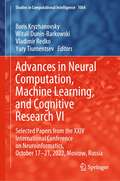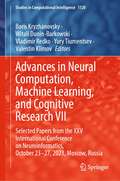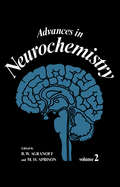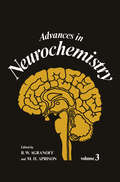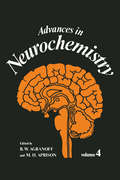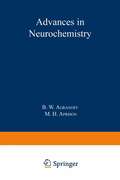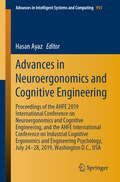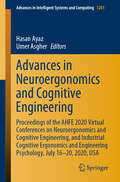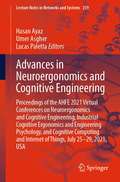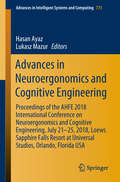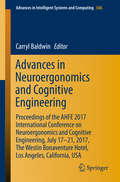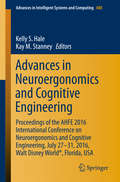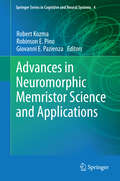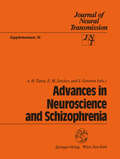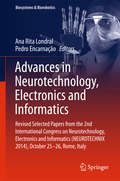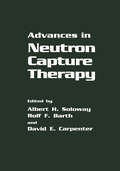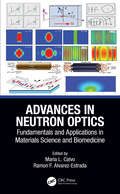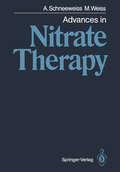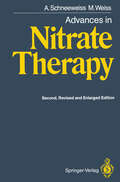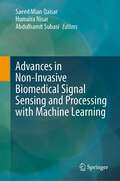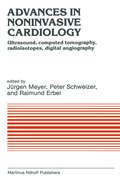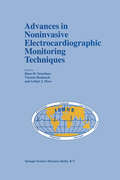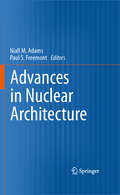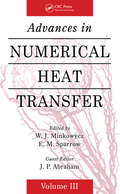- Table View
- List View
Advances in Neural Computation, Machine Learning, and Cognitive Research VI: Selected Papers from the XXIV International Conference on Neuroinformatics, October 17-21, 2022, Moscow, Russia (Studies in Computational Intelligence #1064)
by Boris Kryzhanovsky Witali Dunin-Barkowski Vladimir Redko Yury TiumentsevThis book describes new theories and applications of artificial neural networks, with a special focus on answering questions in neuroscience, biology and biophysics and cognitive research. It covers a wide range of methods and technologies, including deep neural networks, large-scale neural models, brain–computer interface, signal processing methods, as well as models of perception, studies on emotion recognition, self-organization and many more. The book includes both selected and invited papers presented at the XXIV International Conference on Neuroinformatics, held on October 17–21, 2022, in Moscow, Russia.
Advances in Neural Computation, Machine Learning, and Cognitive Research VII: Selected Papers from the XXV International Conference on Neuroinformatics, October 23-27, 2023, Moscow, Russia (Studies in Computational Intelligence #1120)
by Boris Kryzhanovsky Witali Dunin-Barkowski Vladimir Redko Yury Tiumentsev Valentin KlimovThis book describes new theories and applications of artificial neural networks, with a special focus on answering questions in neuroscience, biology and biophysics and cognitive research. It covers a wide range of methods and technologies, including deep neural networks, large-scale neural models, brain–computer interface, signal processing methods, as well as models of perception, studies on emotion recognition, self-organization and many more. The book includes both selected and invited papers presented at the XXV International Conference on Neuroinformatics, held on October 23-27, 2023, in Moscow, Russia.
Advances in Neurochemistry (Cellular Organelles)
by B. W. Agranoff M. H. AprisonIn the Preface to Volume 1, we stated: This series recognizes that investigators who have entered neurochemistry from the biochemical tradition have a rather specialized view of the brain. Too often, interdisci plinary offerings are initially attractive but turn out to recite basic biochemical considera tions. We have come to believe that there are now sufficiently large numbers of neurochemists to support a specialized venture such as the present one. We have begun with consideration of traditional areas of neurochemistry which show considerable scientific activity. We hope they will serve the neurochemist both for general reading and for specialized information. The reader will also have the opportunity to reflect on the unbridled speculation that results from the disinhibiting effects on the author who has been invited to write a chapter. We plan occasionally also to offer reviews of areas not completely in the domain of neurochemistry which we nevertheless feel to be sufficiently timely to be called to the attention of all who use chemical principles and tools in an effort to better understand the brain. The contributions to the present volume pursue these goals. We believe the series has set high standards and has continued to uphold them. In accordance with the principle stated in the last paragraph of the Preface Volume 1, we include in this volume Koshland's "Sensory Response in Bacteria" (Chapter 5).
Advances in Neurochemistry: Volume 3
by B. W. Agranoff M. H. AprisonThe original premise of the Editors in initiating this series was that there existed a readership ofneurochemists with considerable biochemical back ground who would make use of a series dedicated to both new develop ments and specialized reviews in neurochemistry. Having selected our authors, we have offered them virtually complete freedom to reflect and speculate in a field in which they have achieved prominence. The response to the first two volumes has been rewarding. The present one continues in this tradition. While we have not attempted to publish specialized volumes, the present volume contains two somewhat related chapters (Chapters 4 and 5, on the role of amino acid neurotransmitters). The first three chapters examine three diverse approaches, each of current interest, in neurochemi cal approaches to the molecular bases of neuronal and glial structure. B. W. Agranoff M. H. Aprison vii CONTENTS CHAPTER 1 2',3'-CYCUC NUCLEOTIDE 3'-PHOSPHODIESTERASE NEIL RAYMOND SIMS AND PATRICK ROBERT CARNEGIE 1. Introduction. . . . . . . . . . . . . . . . . . . . . . . . . . . . . . . . . . . . . . . . . . . . 1 2. Assay of CNPase . . . . . . . . . . . . . . . . . . . . . . . . . . . . . . . . . . . . . . . 3 2. 1. Need for Activation. . . . . . . . . . . . . . . . . . . . . . . . . . . . . . . . 3 2. 2. Comparison of Assays . . . . . . . . . . . . . . . . . . . . . . . . . . . . . . 3 3. Association of CNPase with Myelin . . . . . . . . . . . . . . . . . . . . . . . 7 3. 1. Historical. . . . . . . . . . . . . . . . . . . . . . . . . . . . . . . . . . . . . . . . . 7 3. 2. Subcellular Fractionation. . . . . . . . . . . . . . . . . . . . . . . . . . . . 8 3. 3. Development. . . . . . . . . . . . . . . . . . . . . . . . . . . . . . . . . . . . . . 8 3. 4. Mutant Mice . . . . . . . . . . . . . . . . . . . . . . . . . . . . . . . . . . . . . . 9 3. 5. Use as a Myelin Marker . . . . . . . . . . . . . . . . . . . . . . . . . . . . 10 3. 6. Myelin-Related Fractions and Peripheral Nerve Myelin. 11 4. CNPase in Nonmyelin Fractions. . . . . . . . . . . . . . . . . . . . . . . . . . 13 5. Activation and Isolation. . . . . . . . . . . . . . . . . . . . . . . . . . . . . . . . . . 13 5. 1. Introduction. . . . . . . . . . . . . . . . . . . . . . . . . . . . . . . . . . . . . . . 13 5. 2. Activation. . . . . . . . . . . . . . . . . . . . . . . . . . . . . . . . . . . . . . . . . 14 5. 3. Solubilization and Fractionation. . . . . . . . . . . . . . . . . . . . . . 15 6. Properties. . . . . . . . . . . . . . . . . . . . . . . . . . . . . . . . . . . . . . . . . . . . . . 19 6. 1. Substrate Specificity. . . . . . . . . . . . . . . . . . . . . . . . . . . . . . . .
Advances in Neurochemistry (Advances in Neurochemistry #4)
by B. W. Agranoff M. H. AprisonThis series has been directed at providing scientists possessing considerable bio chemical background with specialized reviews of neurobiological interest. Some have dealt with completed bodies of research, while others consist of extensive reports of research in progress, judged to be of current interest to the active researcher. We have selected recognized scientists and allowed them freedom to reflect and speculate in the field in which they have achieved prom inence. We note with sadness the passing of Dr. 10rdi FoIch-Pi, who served as an advisory editor when the series was initiated. He played a central role in the development of neurochemistry, as well as the creation of professional societies and journals. He will be remembered fondly by all those whose lives he touched. The editors acknowledge the cooperation of the Upjohn Company in the preparation of the color plate included in this volume. We also acknowledge the skillful editorial assistance of Dr. Kenneth C. Leskawa. We are pleased to honor the retirement of Dr. E. Martin Gal, a former advisory editor of Advances, with the inclusion of a chapter by him in this volume.
Advances in Neurochemistry
by B. W. Agranoff M. H. AprisonThe emergence of a new scientific book series requires some explanation regarding how it hopes to compensate the reader for the discomforts it undoubtedly produces both in the realms of informational input-overload and in the financial strain on personal and institutional budgets. This series recognizes that investigators who have entered neurochemistry from the biochemical tradition have a rather specialized view of the brain. Too often, interdisciplinary offerings are initially attractive but turn out to recite basic biochemical considerations. We have come to believe that there are now sufficiently large numbers of neurochemists to support a specialized venture such as the present one. We have begun with consideration of traditional areas of neurochemistry which show considerable scientific activity. We hope they will serve the neurochemist both for general reading and for specialized information. The reader will also have the opportunity to reftect on the unbridled speculation that results from the disinhibiting effects on the author who has been invited to write a chapter. We plan occasionally also to offer reviews of areas not completely in the domain of neurochemistry which we nevertheless feel to be sufficiently timely to be called to the attention of all who use chemical principles and tools in an effort to better understand the brain. B. W. Agranoff M. H. Aprison vii CONTENTS CHAPTER 1 POSSIBLE ROLES OF PROSTAGLANDINS IN THE NERVOUS SYSTEM LEONHARD S. WOLFE 1. Introduction 1 1. 1. Background 1 Names and Structures 1. 2. 4 1. 3. Biosynthesis 4 1. 4.
Advances in Neuroergonomics and Cognitive Engineering: Proceedings of the AHFE 2019 International Conference on Neuroergonomics and Cognitive Engineering, and the AHFE International Conference on Industrial Cognitive Ergonomics and Engineering Psychology, July 24-28, 2019, Washington D.C., USA (Advances in Intelligent Systems and Computing #953)
by Hasan AyazThis book offers a broad perspective on the field of cognitive engineering and neuroergonomics, covering emerging practices and future trends toward the harmonious integration of human operators and computer systems. It presents novel theoretical findings on mental workload and stress, activity theory, human reliability, error and risk, and neuroergonomic measures alike, together with a wealth of cutting-edge applications. Further, the book describes key advances in our understanding of cognitive processes, including mechanisms of perception, memory, reasoning, and motor response, with a special emphasis on their role in interactions between humans and other elements of computer-based systems. Based on the AHFE 2019 affiliated conference on Neuroergonomics and Cognitive Engineering, held on July 24-28, 2019, in Washington D.C., USA, it provides readers with a comprehensive overview of the current challenges in cognitive computing and factors influencing human performance.
Advances in Neuroergonomics and Cognitive Engineering: Proceedings of the AHFE 2020 Virtual Conferences on Neuroergonomics and Cognitive Engineering, and Industrial Cognitive Ergonomics and Engineering Psychology, July 16-20, 2020, USA (Advances in Intelligent Systems and Computing #1201)
by Hasan Ayaz Umer AsgherThis book offers broad overview of the field of cognitive engineering and neuroergonomics, covering emerging practices and future trends toward the harmonious integration of human operators and computer systems. It presents novel theoretical findings on mental workload and stress, activity theory, human reliability, error and risk, and a wealth of cutting-edge applications, such as strategies to make assistive technologies more user-oriented. Further, the book describes key advances in our understanding of cognitive processes, including mechanisms of perception, memory, reasoning, and motor response, with a particular focus on their role in interactions between humans and other elements of computer-based systems. Gathering the proceedings of the AHFE 2020 Virtual Conferences on Neuroergonomics and Cognitive Engineering, and Industrial Cognitive Ergonomics and Engineering Psychology, held on 16–20 July 2020, this book provides extensive and timely information for human–computer interaction researchers, human factors engineers and interaction designers, as well as decision-makers.
Advances in Neuroergonomics and Cognitive Engineering: Proceedings of the AHFE 2021 Virtual Conferences on Neuroergonomics and Cognitive Engineering, Industrial Cognitive Ergonomics and Engineering Psychology, and Cognitive Computing and Internet of Things, July 25-29, 2021, USA (Lecture Notes in Networks and Systems #259)
by Hasan Ayaz Umer Asgher Lucas PalettaThis book offers a broad overview of the field of cognitive engineering and neuroergonomics, covering emerging practices and future trends toward the harmonious integration of human operators and computational systems. It gathers both theoretical and practice-oriented studies on mental workload and stress, activity theory, human reliability, error and risk. It covers applications in various field, and corresponding strategies to make assistive technologies more user-oriented. Further, the book describes key advances in our understanding of cognitive processes, including mechanisms of perception, memory, reasoning, and motor response, with a particular focus on their role in interactions between humans and other elements of computer-based systems. Gathering the proceedings of the AHFE 2021 Conferences on Neuroergonomics and Cognitive Engineering, Industrial Cognitive Ergonomics and Engineering Psychology, and Cognitive Computing and Internet of Things, held virtually on July 25-29, 2021, from USA, this book offers extensive information and a thought-provoking guide for researchers and practitioners in cognitive engineering, neuroergonomics and their applications.
Advances in Neuroergonomics and Cognitive Engineering: Proceedings of the AHFE 2018 International Conference on Neuroergonomics and Cognitive Engineering, July 21–25, 2018, Loews Sapphire Falls Resort at Universal Studios, Orlando, Florida USA (Advances in Intelligent Systems and Computing #775)
by Hasan Ayaz Lukasz MazurThis book offers a broad perspective on the field of cognitive engineering and neuroergonomics, covering emerging practices and future trends toward the harmonious integration of human operators and computer systems. It presents novel theoretical findings on mental workload and stress, activity theory, human reliability, error and risk, and neuroergonomic measures alike, together with a wealth of cutting-edge applications. Further, the book describes key advances in our understanding of cognitive processes, including mechanisms of perception, memory, reasoning, and motor response, with a special emphasis on their role in interactions between humans and other elements of computer-based systems. Based on the AHFE 2018 affiliated conference on Neuroergonomics and Cognitive Engineering, held on July 21–25, 2018, in Orlando, Florida, USA, it provides readers with a comprehensive overview of the current challenges in cognitive computing and factors influencing human performance.
Advances in Neuroergonomics and Cognitive Engineering: Proceedings of the AHFE 2017 International Conference on Neuroergonomics and Cognitive Engineering, July 17–21, 2017, The Westin Bonaventure Hotel, Los Angeles, California, USA (Advances in Intelligent Systems and Computing #586)
by Carryl BaldwinThis book offers a broad perspective on the field of cognitive engineering and neuroergonomics, covering emerging practices and future trends toward the harmonious integration of human operators with computational systems. It reports on novel theoretical findings on mental workload and stress, activity theory, human reliability, error and risk, and neuroergonomic measures alike, together with a wealth of cutting-edge applications. Further, the book describes key advances in our understanding of cognitive processes, including mechanisms of perception, memory, reasoning, and motor response, with a special emphasis on their role in interactions between humans and other elements of computer-based systems. Based on the AHFE’s main track on Neuroergonomics and Cognitive Engineering, held on July 17–21, 2017 in Los Angeles, California, USA, it provides readers with a comprehensive overview of the current challenges in cognitive computing and factors influencing human performance.
Advances in Neuroergonomics and Cognitive Engineering: Proceedings of the AHFE 2016 International Conference on Neuroergonomics and Cognitive Engineering, July 27-31, 2016, Walt Disney World®, Florida, USA (Advances in Intelligent Systems and Computing #488)
by Kelly S. Hale Kay M. StanneyThis book offers a broad perspective on the field of cognitive engineering and neuroergonomics. It covers emerging practices and future trends towards the harmonious integration of human operators with computational systems. The book reports on novel theoretical findings on mental workload and stress, activity theory, human reliability, error and risk, and neuroergonomic measures alike, together with a wealth of cutting-edge applications. It describes key advances in the understanding of cognitive processes, including mechanisms of perception, memory, reasoning, and motor response, giving a special emphasis to their role in the interactions between humans and the other elements of a computer-based system. Based on the AHFE’s main track on Neuroergonomics and Cognitive Engineering, held on July 27-31, 2016 in Walt Disney World®, Florida, USA, the book provides readers with a comprehensive view of the current challenges in cognitive computing and factors influencing human performance.
Advances in Neuromorphic Memristor Science and Applications (Springer Series in Cognitive and Neural Systems #4)
by Robert Kozma, Robinson E. Pino and Giovanni E. PazienzaPhysical implementation of the memristor at industrial scale sparked the interest from various disciplines, ranging from physics, nanotechnology, electrical engineering, neuroscience, to intelligent robotics. As any promising new technology, it has raised hopes and questions; it is an extremely challenging task to live up to the high expectations and to devise revolutionary and feasible future applications for memristive devices. The possibility of gathering prominent scientists in the heart of the Silicon Valley given by the 2011 International Joint Conference on Neural Networks held in San Jose, CA, has offered us the unique opportunity of organizing a series of special events on the present status and future perspectives in neuromorphic memristor science. This book presents a selection of the remarkable contributions given by the leaders of the field and it may serve as inspiration and future reference to all researchers that want to explore the extraordinary possibilities given by this revolutionary concept.
Advances in Neuroscience and Schizophrenia (Journal of Neural Transmission. Supplementa #36)
by S. Gershon E. M. Stricker A. H. TumaSchizophrenia has been the subject of intense research interest in recent years, as investigators have explored the biological bases for the disorder and for various approaches to its diagnosis and treatment. This volume focuses on three aspects of such recent research connecting basic neuroscience to schizophrenia. In one, Professors Budinger, Gur, and Pettegrew provide critical reviews of brain imaging studies as they relate to cognitive behaviour functions in schizophrenia. In the second, Professors Goldmann-Rakic, Lewis, and Tassin discuss monoamine systems and their varied role in prefontal cortical circuitry and function. In the third, Professors Deutsch, Gerfen, and Grace discuss the structure, organization, and function of the basal ganglia, as they relate to schizophrenia and the mechanisms of neuroleptic action. These papers were presented at an interdisciplinary workshop on the subject at the University of Pittsburgh, in May 1991, and the discussion between the authors and other panelists in basic and clinical sciences are included in this volume as well. The presentation of these diverse approaches in an integrated fashion provides the reader with a unique perspective and a wealth of new questions for future collaborative research.
Advances in Neurotechnology, Electronics and Informatics: Revised Selected Papers from the 2nd International Congress on Neurotechnology, Electronics and Informatics (NEUROTECHNIX 2014), October 25-26, Rome, Italy (Biosystems & Biorobotics #12)
by Ana Rita Londral Pedro EncarnaçãoThis book is a timely report on current neurotechnology research. It presents a snapshot of the state of the art in the field, discusses current challenges and identifies new directions. The book includes a selection of extended and revised contributions presented at the 2nd International Congress on Neurotechnology, Electronics and Informatics (NEUROTECHNIX 2014), held October 25-26 in Rome, Italy. The chapters are varied: some report on novel theoretical methods for studying neuronal connectivity or neural system behaviour; others report on advanced technologies developed for similar purposes; while further contributions concern new engineering methods and technological tools supporting medical diagnosis and neurorehabilitation. All in all, this book provides graduate students, researchers and practitioners dealing with different aspects of neurotechnologies with a unified view of the field, thus fostering new ideas and research collaborations among groups from different disciplines.
Advances in Neutron Capture Therapy
by David E. Carpenter Rolf F. Barth Albert H. SolowayBinary systems for the treatment of cancer potentially are among the most attractive of the new therapeutic modalities that currently are under investigation. The basicconcept is to selectivelydestroy malignantcells whileconcomitantlysparing normal tissue. Neutron capture therapy (NCT) is the binary system that has been the subject of the Fifth International Symposium on Neutron Capture Therapy, which was held September13-17, 1992, in Columbus, Ohio, undertheauspicesoftheInternational Society for Neutron Capture Therapy. Its objective was to bring together researchers from throughout the world and to provide a forum at which they could present the latest advances in the development of Neutron capture therapy. Neutron capture therapy has largely, but not exclusively, focused on the use of boron-10 as the target nuclide. Boron neutron capture therapy (BNCT) is based on the nuclear reaction that occurs when the stable isotope, boron-10, absorbs low-energy non ionizing thermal neutrons to yield alphaparticles and recoiling lithium-7 nuclei. The size and energy of these high linear energy transfer (LET) particles result in their being confined largely to the cells in which the capture reaction occurs. For BNCT to be successful, a sufficient numberof I~atoms mustbe localized within neoplastic cells, and enough thermal neutrons must be delivered and absorbed by the I~ to produce a lethal 1~(n,QVLi reaction. Two major problems must be surmounted.
Advances in Neutron Optics: Fundamentals and Applications in Materials Science and Biomedicine (Multidisciplinary and Applied Optics)
by Maria L. Calvo Ramon F. Alvarez-EstradaNeutron optics studies the interactions of a beam of slow neutrons with matter. This book updates various advances on neutron optics. There will be a focus on the very active topics of neutron imaging (NI) and neutron spin optics (NSO). The book will also present applications of neutron beams in biomedicine, such as Boron Neutron Capture Therapy (BNCT) and related techniques. Features: Discusses diffraction and interference of slow neutrons, including computational approaches Reviews neutron imaging (NI) and neutron spin optics (NSO) Treats two major sources of slow neutron beams: (1) fission reactions at nuclear reactors and (2) collisions in particle accelerators (small ones, spallation sources) of charged particle beams with targets of heavy atoms Selects subjects on fundamental quantum aspects of slow neutrons and on confined propagation and waveguiding thereof Updates slow neutron beams and BNCT
Advances in Neutron Optics: Fundamentals and Applications in Materials Science and Biomedicine (Multidisciplinary and Applied Optics)
by Maria L. Calvo Ramon F. Alvarez-EstradaNeutron optics studies the interactions of a beam of slow neutrons with matter. This book updates various advances on neutron optics. There will be a focus on the very active topics of neutron imaging (NI) and neutron spin optics (NSO). The book will also present applications of neutron beams in biomedicine, such as Boron Neutron Capture Therapy (BNCT) and related techniques. Features: Discusses diffraction and interference of slow neutrons, including computational approaches Reviews neutron imaging (NI) and neutron spin optics (NSO) Treats two major sources of slow neutron beams: (1) fission reactions at nuclear reactors and (2) collisions in particle accelerators (small ones, spallation sources) of charged particle beams with targets of heavy atoms Selects subjects on fundamental quantum aspects of slow neutrons and on confined propagation and waveguiding thereof Updates slow neutron beams and BNCT
Advances in Nitrate Therapy
by Adam Schneeweiss Marija WeissAll aspects of nitrate therapy, including conventional and new formulations and delivery systems, are covered in this book. For each drug the formulation, mechanism of action, indications, effects, adverse reactions and special problems are systematically described. The use of nitrates in specific population groups, such as infants, children and the elderly, is dealt with separately. The book is updated, based not only on the world literature but also on the most recent conference presentations, and provides the reader with thorough and practice-oriented coverage.
Advances in Nitrate Therapy
by Adam Schneeweiss Marija WeissNitrates have been for many years the cornerstone of cardiovascular therapy for various indications. Not only have nitrates stood the test of time for treatment of chronic stable angina pectoris, but the indications for them have markedly ex panded. They now include all forms of angina pectoris and myocardial ischemia, congestive heart failure and hypertensive emergencies. The beneficial effects of nitrates in all these conditions result from their vasodilatory properties, but it is still unclear whether the central or peripheral effects predominate in the thera peutic mechanism. Recently nitrates have been shown to fulfill the most important requirement for each and every drug - to reduce mortality. A large scale study revealed that isosorbide dinitrate, combined with hydralazine, reduced long-term mortality by 28% in patients with congestive heart failure. This finding will certainly stimulate research on nitrates, and it might be expected that interest in these drugs will markedly increase. The primarily used nitrates in clinical practice are nitroglycerin and the com plex organic nitrates, mainly isosorbide dinitrate. The organic mononitrates are now under clinical investigation, and isosorbide-5-mononitrate (IS-5-MN) appears to be especially promising.
Advances in Non-Invasive Biomedical Signal Sensing and Processing with Machine Learning
by Saeed Mian Qaisar Humaira Nisar Abdulhamit SubasiThis book presents the modern technological advancements and revolutions in the biomedical sector. Progress in the contemporary sensing, Internet of Things (IoT) and machine learning algorithms and architectures have introduced new approaches in the mobile healthcare. A continuous observation of patients with critical health situation is required. It allows monitoring of their health status during daily life activities such as during sports, walking and sleeping. It is realizable by intelligently hybridizing the modern IoT framework, wireless biomedical implants and cloud computing. Such solutions are currently under development and in testing phases by healthcare and governmental institutions, research laboratories and biomedical companies. The biomedical signals such as electrocardiogram (ECG), electroencephalogram (EEG), Electromyography (EMG), phonocardiogram (PCG), Chronic Obstructive Pulmonary (COP), Electrooculography (EoG), photoplethysmography (PPG), and image modalities such as positron emission tomography (PET), magnetic resonance imaging (MRI) and computerized tomography (CT) are non-invasively acquired, measured, and processed via the biomedical sensors and gadgets. These signals and images represent the activities and conditions of human cardiovascular, neural, vision and cerebral systems. Multi-channel sensing of these signals and images with an appropriate granularity is required for an effective monitoring and diagnosis. It renders a big volume of data and its analysis is not feasible manually. Therefore, automated healthcare systems are in the process of evolution. These systems are mainly based on biomedical signal and image acquisition and sensing, preconditioning, features extraction and classification stages. The contemporary biomedical signal sensing, preconditioning, features extraction and intelligent machine and deep learning-based classification algorithms are described. Each chapter starts with the importance, problem statement and motivation. A self-sufficient description is provided. Therefore, each chapter can be read independently. To the best of the editors’ knowledge, this book is a comprehensive compilation on advances in non-invasive biomedical signal sensing and processing with machine and deep learning. We believe that theories, algorithms, realizations, applications, approaches, and challenges, which are presented in this book will have their impact and contribution in the design and development of modern and effective healthcare systems.
Advances in Noninvasive Cardiology: Ultrasound, computed tomography, radioisotopes, digital angiography (Developments in Cardiovascular Medicine #24)
by RaimundErbel PeterSchweizer JürgenMeyerAdvances in Noninvasive Electrocardiographic Monitoring Techniques (Developments in Cardiovascular Medicine #229)
by Arthur J. Moss VinzenzHombach Hans-H. OsterhuesNoninvasive electrocardiographic monitoring is a fundamental part of cardiology. Depending on continuous improvements and developments of new technologies, these methods are essential for diagnosis and risk stratification of patients. The rapid changes in the capabilities, technologies and diagnostic values of the different methods force us to update our knowledge continuously. This book offers a comprehensive overview of the current state and future developments in the field of noninvasive electrocardiographic monitoring techniques. In addition, related fields such as magnetocardiography, newer signal detection and analysis techniques as well as ambulatory blood pressure monitoring are reported. The different methods are discussed with regard to methodological aspects, latest technical developments and clinical value of results. Furthermore, review articles focus on the autonomic nervous system, monitoring of ischemic heart disease, quality control and standardization of monitoring techniques. A group of international experts in science and clinical practice have contributed to this book, which is supported by the International Society for Holter and Noninvasive Electrocardiography (ISHNE). The book is addressed to clinical and academic cardiologists as well as scientists.
Advances in Nuclear Architecture
by Niall M. Adams and Paul S. FreemontThis book provides a snapshot of the state-of-the art in the study of mammalian cell nuclear architecture, and features a diverse range of chapters written by top researchers. A key aspect is an emphasis on precise and repeatable quantitative analysis and simulation in addition to the more familiar biological perspective. The fusion of such material frames the future of the discipline. Quantitative contributions stress reproducible and robust 3D analysis, using a variety of tools ranging from point pattern analysis to shape registration methods. Biological insights include the role of nuclear subdomains in cancer, nuclear molecular motors, and a holistic view of gene transcription.
Advances in Numerical Heat Transfer, Volume 3
by W. J. MinkowyczDefinitive Treatment of the Numerical Simulation of Bioheat Transfer and Fluid FlowMotivated by the upwelling of current interest in subjects critical to human health, Advances in Numerical Heat Transfer, Volume 3 presents the latest information on bioheat and biofluid flow. Like its predecessors, this volume assembles a team of renowned internatio
